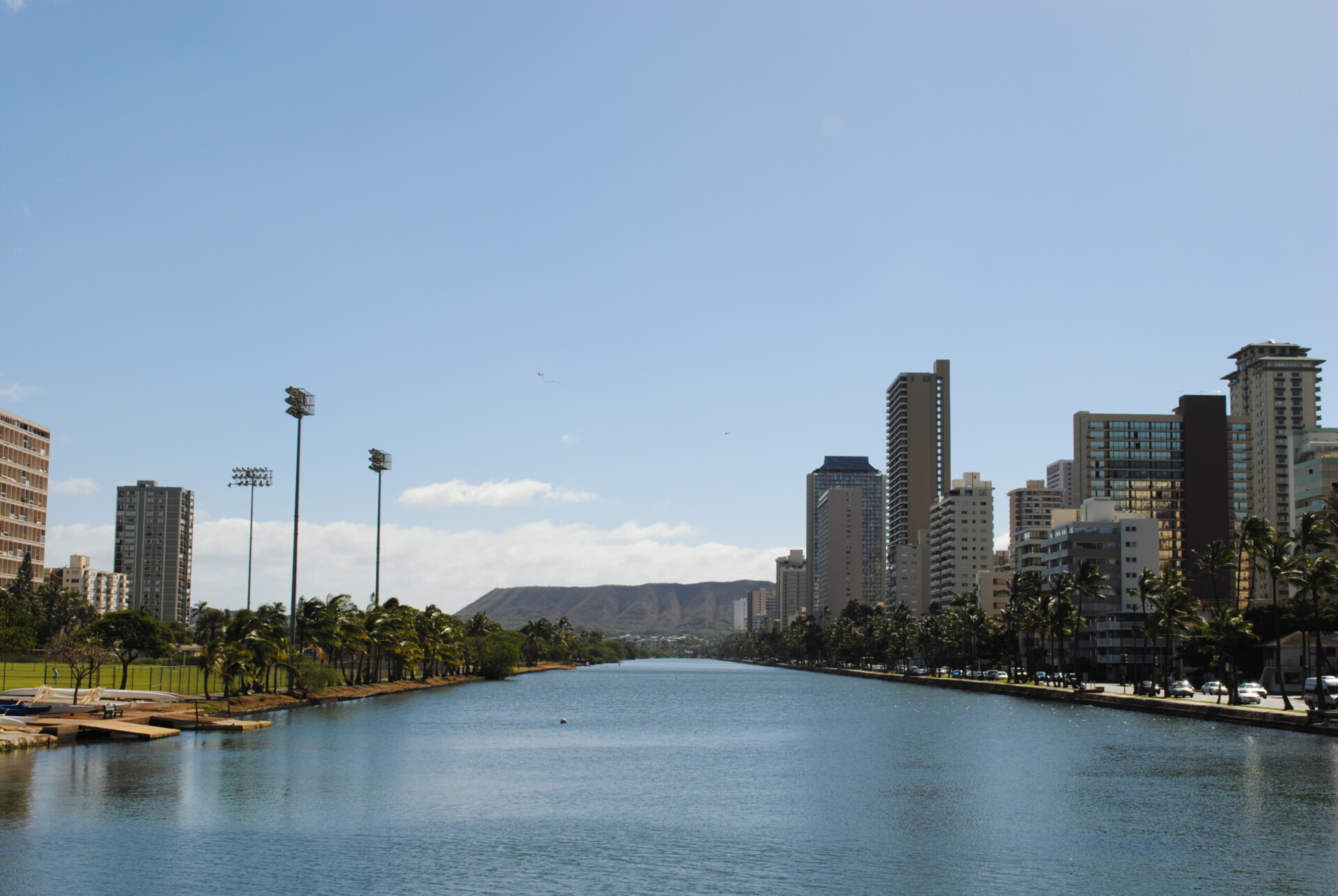
COMMUNITY MEETING SET FOR ALA WAI BRIDGE DISCUSSION
9/7/23: The proposed Ala Wai pedestrian bridge will be the focus of a community meeting on Saturday, September 9. The gathering is organized by State Senators Les Ihara Jr. and Carol Fukunaga to enable the community to discuss the City & County of Honolulu’s plans for a 180-foot tall bridge over the historic Ala Wai Canal.
The meeting will begin at 2:00 p.m. (registration opens at 1:30) in the Ala Wai Elementary School Cafeteria, 503 Kamoku Street. RSVP to 808-586-6250 or m.vomvoris@capitol.hawaii.gov.
Historic Hawai‘i Foundation is a consulting party to the City and its State and Federal partners under Section 106 of the National Historic Preservation Act to assess impacts from the proposed bridge on historic properties and cultural resources. Throughout the historic preservation and environmental review processes, HHF has provided input about the proposed bridge design, finding that it is out of scale with the setting and will be adverse to the historic canal, the Hawaiian koa canoe Malia and the traditional and customary practice of paddling.
“The new bridge should reflect its own time and place, not replicate existing bridges or establish a false sense of history. However, oversized or overly elaborate structures should also be avoided. The new bridge should be elegant but subordinate to the setting and context,” HHF Executive Director Kiersten Faulkner wrote in comments to the project proponents. “A more appropriate design would have a low profile, protect the current unimpeded views to and from Diamond Head, have an open feel and send of connection to the surrounding landscape, and have a modern or minimalist character.”
The meeting will include small group discussions to develop priorities. “Our approach has been to empower the community rather than having legislators solely address the problems,” Ihara said.
The State Senators plan to hold a follow-up meeting on September 19, 5:30 p.m. at Washington Middle School to report back on action items and priorities for community action.
In addition to the proposed bridge, the follow-up meeting will include discussions about other development proposals in the Ala Wai Watershed. “We hope to expand the community’s capabilities and resources to address community interests related to the Ala Wai watershed and flood control project, housing and other proposed developments, and perhaps conduct watershed activities to improve our community,” Ihara said. “We believe that by neighborhoods working together we can build consensus on common community goals, and then take small collective actions to pursue them. A community network would also encourage legislators to work together for common regional issues.”
Senator Ihara said, “We plan to enable community members to address various projects and issues in the watershed area. For example, updates on the watershed flood control project, Ala Wai bridge, Kuilei Place, Pahoa Ridge Apartments, Manoa Cemetery housing proposal, Primary Urban Center Development Plan, and other matters in the watershed area.”

Rendering courtesy Honolulu Department of Transportation Services
The City and County of Honolulu Department of Transportation Services (DTS), in partnership with Hawai‘i Department of Transportation (HDOT) and the Federal Highway Administration (FHWA) is proposing a new pedestrian and bicycle bridge over the Ala Wai Canal in Waikīkī.
The City says that the purpose of the proposed project, known as “Ala Pono,” is to provide safe access for people traveling by foot or by bicycle across the Ala Wai Canal between Ala Moana Boulevard and the Mānoa/Pālolo Stream. The project’s goal is to improve multimodal network connectivity and enhance public safety for people walking and bicycling.
The proposed bridge is a cable-stayed design with an asymmetric configuration that utilizes a main pylon sited on the mauka side of the canal. The proposed bridge would not physically adhere to the Ala Wai Canal walls and no permanent structures would be installed in the canal.
On the mauka end of the bridge, a 180-foot tower would straddle a cast-in-place deck that would cantilever over the water. Some 26 cables and two backstay anchors would support the bridge. The makai landing would sit on the Ala Wai Promenade, incorporate a stair and a ramp, supported by a concrete abutment some 12.5-feet high, 15 feet wide and 172 feet in length. The ramp would cantilever over the canal floodwall by almost 10 feet.

Rendering courtesy Honolulu Department of Transportation Services
The City identified historic properties and cultural resources within the project area. The most significant effect on historic properties is to the Ala Wai Canal itself. The canal is 100 years old and is listed on the Hawai‘i Register of Historic Places. The extant character-defining features of the Ala Wai Canal that convey its significance are a combination of physical and contextual environmental features.
The City noted that, “The most noticeable characteristics from a distance are; 1) the broad body of water channeled within it, and, 2) the open space above and around it. The virtually flat elevation of the canal and its adjacent embankments are well in keeping with the 25’ height limit (Land Use Ordinance Chapter 21-9.40), and the recommendations of the Diamond Head Special District Design Guidelines imposed upon the canal area.”
The archaeological literature review also identified a potential subsurface site (SIHP #50-80-14-5796) that would be affected. HHF, Native Hawaiian Organizations and other community members have also expressed strong concerns about the project’s potential to affect the koa canoe Malia (listed on the State Register) as well as sites and objects associated with traditional and customary practices of paddling.
HHF submitted written comments on the Draft Environmental Assessment in April, and is actively participating as a consulting party in the Section 106 process.

